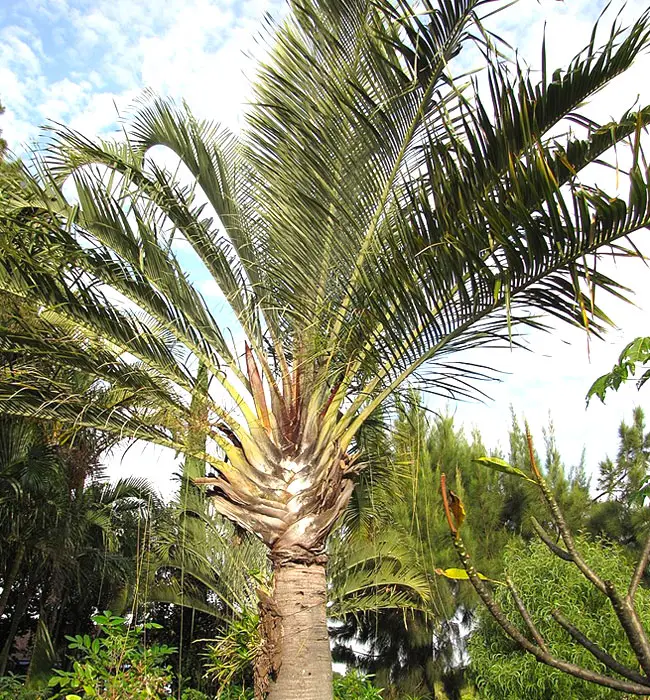
The Triangle Palm Tree, scientifically known as Dypsis decaryi, is a remarkably striking palm due to its leaves that are arranged in three ranks and form a distinctive triangular shape.
This palm serves as an exceptional ornamental plant, suitable for both indoor and outdoor cultivation, where it can truly showcase its unique form.
Quick Facts:
| Scientific name: | Dypsis decaryi |
| Common names: | Triangle Palm, Three Sided Palm, Neodypsis decaryiraveler’s Tree. |
| Origin: | Native to Madagascar Island. |
| Growth Rate: | Moderate.Up to 25 – 30 ft tall and 12-15 ft wide. |
| Cold Tolerance: | USDA Zones 10a (30 – 35 F) to 11 (above 40 F). |
| Light Req: | Full sun. |
| Water Req: | Drought tolerant. |
| Soil Req: | Widely adaptable |
| Fruit: | Yes. Black. Not edible. |
| Propagation: | By seeds germinating in 1-2 months. Division. |
Identifying Characteristics of the Triangle Palm
It features a single, smooth, upright trunk with a diameter ranging from 9 to 13 inches. The trunk displays a brownish-gray hue, marked by the remnants of fallen fronds.
Overlapping leaf bases emerge from three distinct points on the trunk, creating the unmistakable triangular configuration that gives this palm its name: Triangle Palm.
The leaves are pinnate, or feather-like, arching almost upright, measuring approximately 10 feet in length and 3 feet in width. They are segmented, with a bluish-green color on both the upper and lower surfaces. These leaves are supported by brown petioles covered in a whitish bloom.
Flowers and Fruits of the Flowers and Fruits
The Triangle Palm produces yellowish-green flowers held by 4-foot-long branched petioles that emerge from the lower leaves.
It is a monoecious palm, bearing both male and female flowers on the same plant. The flowers are followed by round, black, inedible fruits measuring about 1 inch in diameter. This palm’s year-round blooming adds to its visual appeal.
How To Care For Triangle Palm
Dypsis decaryi can reach heights of 10 to 20 feet and has a width of 10 to 15 feet. It is versatile enough to be grown indoors as well.
This palm can endure temperatures as low as 30°F for short periods, but it should be kept as dry as possible during cold spells. It is well-suited for USDA Zones 10a (30 to 35°F) to 11 (above 40°F).
While the Triangle Palm thrives in full sun, it can also tolerate light shade. It does not require excessive watering, so it’s essential to let the soil dry between waterings and ensure good drainage. A general-purpose potting soil with added sand can be used.
To prevent nutritional deficiencies, it’s advisable to apply a high-quality palm fertilizer with a continuous-release formula twice a year during the growing season.
Propagation of the Triangle Palm can be done through seeds or division. Seeds typically germinate in just 1-2 months, making it a relatively straightforward process.
Triangle Palm Tree Pictures








More information can be found on EDIS and Floridata sites.

What is the root system like on triangle palm.
I want near pool but worry it will dig under the tiles.
our triangle palm is getting long vertical cracks on the trunk, and the lower fronds are turning yellow and brown. do you have any suggestions as to what is causing these problems?